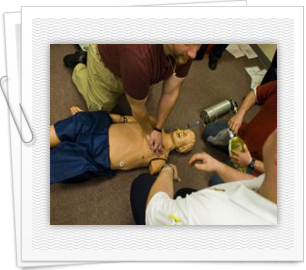Online CPR Certification Blog
Compression only CPR gets more support
Date: October 24th, 2013
 In a trial done in US, which involved nearly 2000 patients, about 12.5 percent were discharged from the hospital after receiving chest compression compared to 11 percent of the patients who received the chest compression together with rescue breathing together. The compression alone triumphed with a slight edge.
In a trial done in US, which involved nearly 2000 patients, about 12.5 percent were discharged from the hospital after receiving chest compression compared to 11 percent of the patients who received the chest compression together with rescue breathing together. The compression alone triumphed with a slight edge.
Layperson CPR proves to be more effective
According to the study, chest compression alone improved the chances of survival for two major subgroups of patients involved in the study. These included the patients with cardiac arrest as well as those with arrhythmias condition, which could be treated effectively with defibrillation. The study findings first appeared in New England Journal of Medicine. According to Thomas D. Rea, from University of Washington, Seattle, chest compression alone showed a consistently much better outcomes which made it the most preferable kind of CPR treatment. These results showed that CPR strategy of a layperson that majorly emphasize on chest compression while minimizing the role played by rescue breathing is much more effective and recommended.
When the study findings were analyzed together, there was an undisputed conclusion that practicing chest compression alone had similar survival chances compared to the one with ventilation, says Myron Weisfeldt, MD at Johns Hopkins. The mouth to mouth CPR Rescue breathing is not only difficult to practice but many people also find it rather distasteful. As such, they advocate for continuous chest compression alone by a bystander where ventilation isn’t involved. This can boost the chance of the patient surviving a cardiac arrest, continued Weisfeldt, former president of American Heart Association.
Interest in bystander CPR continue to grow
When a bystander initiates CPR in the early stages, this can boost the survival chances and improve the long term recovery from neurologic conditions. Traditionally, CPR has mainly comprised of chest compressions that are interspersed with the rescue breathing. However, recent years have seen more interest growing in the bystander CPR which emphasizes mostly on chest compression and eliminates or minimizes rescue breathing, as noted by Rea and co- authors. Weisfeldt suggests that practicing chest compression alone is much more acceptable for laypersons. Past studies suggest that chest compression alone CPR can improve survival by increasing circulation.
In overall, the study further supports to the widely believed notion that CPR involving chest compression alone, which can be learnt and performed easily, is the more preferred CPR method that should be practiced by bystanders to help cardiac arrest patients. These conclusions were heavily seconded by other specialists of emergency medicine and cardiology in U.S. For by-standers who have no training in CPR, the person operating 911 services can effectively coach the bystander on how to perform the chest compression alone easily unlike chest compressions with ventilation. However, these findings do not in any way suggest that people who are trained on CPR including bystanders shouldn’t try ventilating the patient because at some point, the person will need oxygen.